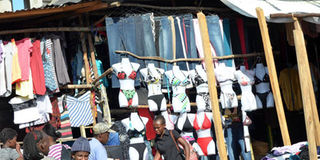Relief as East Africa postpones ban on mitumba

Second hand 'Mitumba' clothes on display at an open stall at the Kongowea Market in Mombasa in this photo taken on July 6, 2015. PHOTO | KEVIN ODIT
What you need to know:
- A joint communiqué by the member states also proposed a complete ban on exports of raw hides and skins outside the trade bloc in a move meant to save the local industries suppressed by the influx of the used commodities from China, Europe and America.
Traders dealing in used clothes got a temporary relief after the East African Community heads of state postponed the planned ban on mitumba to 2018.
President Uhuru Kenyatta, his Tanzanian counterpart John Magufuli, Uganda’s Yoweri Museveni and Rwanda’s Paul Kagame agreed to have the plan implemented in a stretch of three years, giving the traders a grace period.
Fears were rife that had the ban taken effect immediately, it would leave thousands of families without a lifeline.
A joint communiqué by the member states also proposed a complete ban on exports of raw hides and skins outside the trade bloc in a move meant to save the local industries suppressed by the influx of the used commodities from China, Europe and America.
Textile and leather
“The summit, being desirous of promoting vertically integrated industries in the textile and leather sector, directed the partner States to procure their textile and footwear requirements from within the region where quality and supply capacities are available competitively, with a view to phasing out importation of used textile and footwear within three years,” read the statement released yesterday.
In Kenya where Africa’s largest second hand clothes market, Gikomba, is situated, employs close to 60,000 people. The cheap items come mainly from Europe and America and are sold in bales in Nairobi, from where the merchandise is taken to other parts of the country.
Their reasonable prices and availability in large volumes is blamed for the collapse of the country’s textile industry said to have employed close to 500,000 people in the 1980s.





